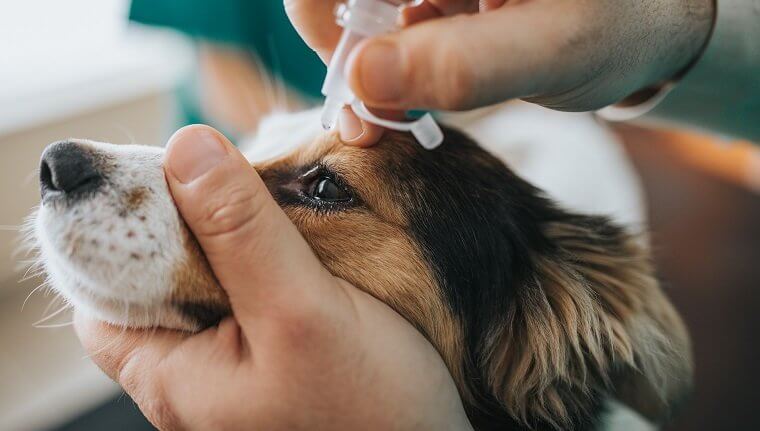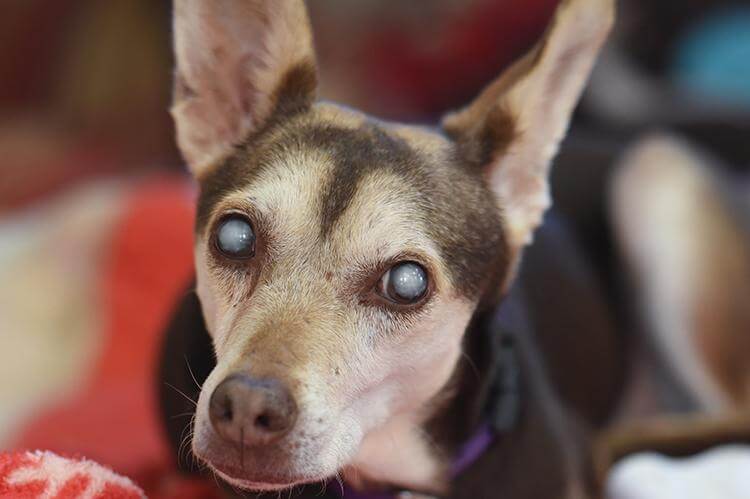Traditionally, there have been no medications used in the treatment of opacified eye lenses.
Medical practitioners relied solely on the surgical removal of cloudy lenses from the eye and replacing them with artificial lenses to treat cataracts.
However, thanks to advancements in technology, it is possible to circumvent the hassles that come with eye surgery by utilizing eye drops to treat cataracts.
Many canine experts and dog parents are increasingly embracing Lanosterol eye drops as viable alternatives to cataracts surgery for dogs.
What is Lanosterol?
Essentially, Lanosterol is an organic steroid found in the bodies of all animals.
But over the past few years, it has been included in many OTC ophthalmic products to treat or manage cataracts in humans and pets.
In 2015, Dr. Zhang, the chief of ophthalmological genetics at the University of California, alongside a team of well-versed ophthalmologic scholars, conducted a series of experiments looking into the potential for Lanosterol to cure cataracts.
After testing Lanosterol on the eye lenses of lab mice, dogs, and rabbits, the researchers concluded that this organic compound has the capacity to manage and eliminate eye opacity.
They published their research findings in a July 2015 Nature Magazine wherein they explained that the Lanosterol compound breaks down and dissolves blocks of protein that form the clouds that bring about cataracts, thus eliminating the resultant opacity.
Another 2018 study also showed that Lanosterol has the potential to improve eye clarity in people with cloudy lenses.
It is these studies that have prompted people to start looking into the possibility of including Lanosterol in ophthalmic products as a promising cataract treatment for humans and pets.
How Lanosterol Works
Lanosterol is believed to work by reducing protein aggregation within the eye lens. It is the protein aggregation or sticking together that causes cloudiness in the eye.
However, the exact mechanism by which this steroid detangles or prevents the aggregation of proteins is still not yet known.
An eye drop formulated with Lanosterol is believed to deliver a small amount of the steroid to detangle a portion of the lens’ cataract.
This means that regular usage can go a long way in offsetting the progression of the condition, slowing it down.
But Do Lanosterol Eye Drops Clear Cataracts in Dogs?

The short answer is: more research is still needed to reach a conclusion.
As of the time of writing this post, expert opinions vary.
On one hand, there are people who are in agreement that Lanosterol may reduce cataracts in dogs.
To validate their assertions, they cite multiple studies, including:
- Dr. Zhang’s 2015 study which concluded that Lanosterol breaks down proteins that cause cloudy eye lenses, ultimately eliminating the resulting opacity.
- A 2018 observational case study of Lanosterol’s effect on human beings over a period of eight months, which showed that this compound has a stabilizing effect on progressive cataracts, implying that it can manage this condition accordingly.
- A journal entry published in the IOVS, which stipulates that Lanosterol is an effective therapeutic agent for people suffering from cataracts as it effectively eradicates the lens cloudiness, while also preventing a buildup of opacity in early-stage cataracts.
On the other hand, there are experts who believe that Lanosterol has little to no effect on dog cataracts.
This group claims that there is still very little research carried in live animals.
According to them, most of the past researches have been conducted in the lab on lenses in Petri dishes soaked in Lanosterol solutions—which is different from real-life eye drop that has to travel through the cornea into the anterior chamber into the lens capsule.
In fact, 6 months after Dr. Zhang’s study, C. Minija published another study criticizing Lanosterol’s ability to treat cataracts on the account that this compound has extremely low solubility.
The study noted that it is overly difficult for Lanosterol eye drops to penetrate the eye’s crystalline lens due to its limited solubility.
Ideally, this low chemical solubility makes it hard for the compound to penetrate the pupil, iris, cornea, and anterior.
True to this line of thought, Dr. Zhang’s team injected Lanosterol solutions intravenously in the eye before administering Lanosterol eye drops for added effectiveness.
The dogs were anesthetized beforehand to administer the injection, and the eye drop solution was then administered three times a day for six weeks.
Minija’s study concluded that the intravenous injection added to the eye drops effectiveness.
Put simply, there are still a lot of question marks regarding the efficacy of Lanosterol as an eye drop, especially when it comes to a suitable delivery system.
But research is ongoing and one commercial company, Lanomax, claims to have a solution with their nanotechnology product—Thru Delivery System.
The substances that are part of this delivery system detach Lanosterol molecules from the drug’s complex and quickly pass them across the pupil, anterior, cornea, and iris, to ensure maximum therapeutic efficacy.
The Verdict
More research is still needed to establish whether Lanosterol eye drops can be a viable treatment for canine cataracts.
So, should you ditch Lanosterol eye drops for dogs? Not at all!
Even if expert opinions vary, there are still many ways your dog can benefit from these eye drops:
- You can use Lanosterol eye drops as a preventative measure. We know that some dogs are more prone to cataracts than others. If yours falls in this group, you may use Lanosterol eye drops to prevent cataracts from forming in the first place.
- The eye drops can slow the progression of the condition. While Lanosterol-based eye drops may not fully clear cataracts, they can prevent your Fido’s cataracts from getting worse.
- Finally, when you read the reviews left by hundreds of dog owners who have had success treating their dogs with lanosterol eye drops, it is hard to believe that they are all imagining or faking the improved vision of their dogs and even themselves.
To this end, I believe that there is no reason why any dog owner who doesn’t want to go the surgery direction shouldn’t try lanosterol eye drops for his or her dog’s cataract.
The most important thing to do is to talk with your vet first before you begin the treatment.
Lanosterol Eye Drops for Dogs Side Effects
Lanosterol is completely safe for use on your dog. It has no known side effects.
Remember that the steroid is naturally found in all animals, so there are less chances of it causing adverse reactions.
Granted, it can cause a minor sting in the eye, especially during application.
Your dog will likely react to the sting during the first application, but it will be smooth sailing from then on.
It is also important to note that Lanosterol eye drops should be disposed of thirty days after opening the pack.
The medication loses potency after this duration, and thus should not be used afterward.
If your dosage is not complete after thirty days, you are required to get a new pack.
Also, to retain optimum potency during this thirty-day period, store the opened pack in a cool place (preferably a fridge) and avoid exposing it to direct sunlight.
Where to Buy Lanosterol Eye Drops for Dogs
Lanosterol is available for OTC (over-the-counter) purchases in a wide array of pet pharmacies and convenience stores.
You can get these eye drops from online pet pharmacies and specialty stores such as Lumenpro, Good Dog People, Pet Health Global, Lanomax, and Push Paw.
You can also buy this eye drop from online retail giants like Wal-Mart and Amazon (use the link below).
Do You Need a Prescription for Lanosterol?
No, you don’t need a prescription to purchase Lanosterol eye drops for your dog.
This is because it is not considered a drug, but instead an eye vision supplement.
However, it is advisable to seek professional guidance from your veterinarian with specific regard to dosage and suitability of use by your dog before buying this medication.
Closing Thoughts
In sum, Lanosterol eye drops show immense promise for the future of cataract treatment in dogs.
This organic compound is believed to effectively break down proteins that cause opacity in the eye lenses, thereby acting as a therapeutic agent for cataracts.
Although surgery is more effective and can go further to correct other related problems that are exacerbated by cataracts including nearsightedness, using Lanosterol eye drops is a safe, non-invasive treatment option.
If your dog has cataracts, you should definitely consider using Lanosterol eye drops as they will help replenish his eye vision.
However, ensure you seek your vet’s guidance beforehand for safe and effective use of these eye drops.
Related:
10 Best Eye Drops for Dogs with Cataracts
Pros and Cons of Cataract Surgery for Dogs
Is Saline Solution Safe for Dog’s Eyes?
As an Amazon Associate, we may receive a small commission from qualifying purchases but at no extra cost to you. Learn more. Amazon and the Amazon logo are trademarks of Amazon.com, Inc, or its affiliates.


